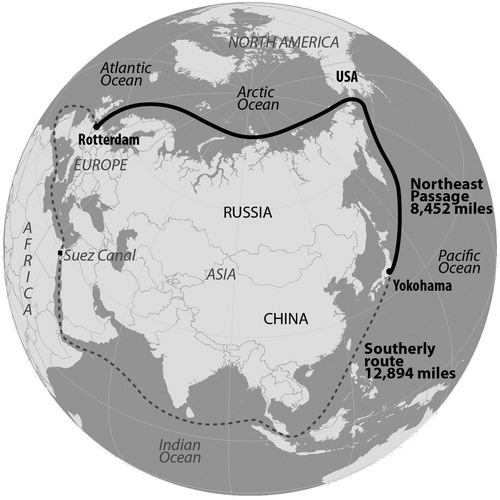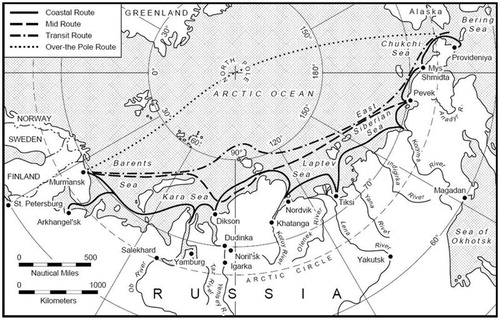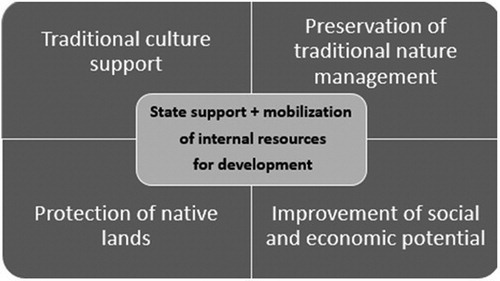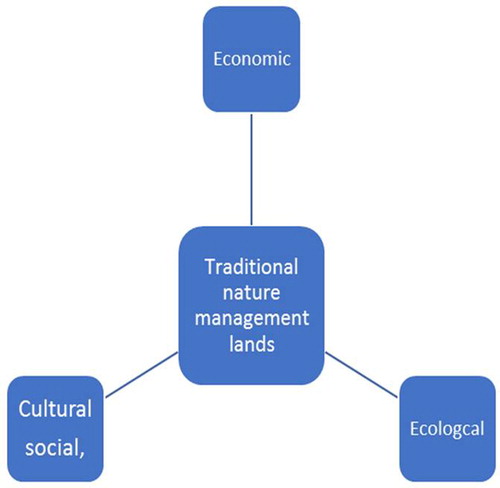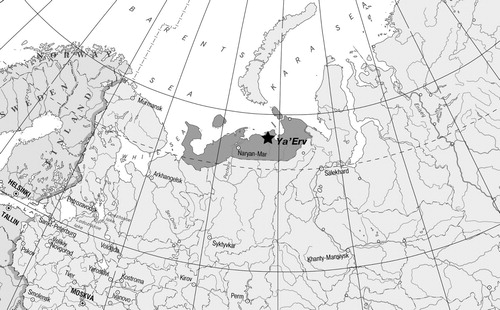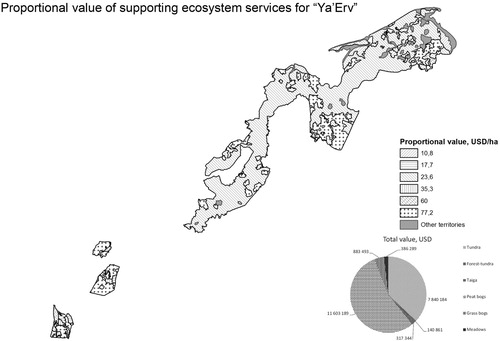ABSTRACT
Territories of traditional nature use (TTNU) of indigenous population in the Arctic zone presents a historical model of sustainable development whose main principles are valuable for modern practice of economic activities in this region as well. Indigenous peoples traditional nature management practice in the Russian Arctic nowadays exists only within tribal community lands, though their virtual limits may be larger and known to indigenous population, helping to preserve regional identities. Preservation of TTNU in the course of modern economic development, including the Northern Silk Road coastal infrastructure, is important for regional ecological and social stability. They may be regarded as ecological buffer zones, restoring ecosystem functions important for regional sustainable development, though modern market economy treats them mainly as economic units less valuable for incomes than industrial. A new look at TTNU may be supported by their ecological-economic assessment. A case study in the coastal Nenets TTNU belonging to family-clan community ‘Ya’Erv’ demonstrates its possible input to local sustainable development.
1. Introduction
Since the beginning of the twenty-first century, the Arctic zone attracts the attention of many states, including even those which are situated far from it. This is explained by important functions of the Arctic region in the modern world: resource (13% of the world’s undiscovered oil resources and one-third of its undiscovered natural gas resources); communication; geopolitical, cultural (including ethnic-cultural) and biodiversity preservation; the key role in energy and matter fluxes at regional and global scale. Nowadays, a new paradigm of economic and geostrategic development promotes international cooperation in the Arctic. The Northern Sea Route revitalization and development present activities in this field. Russia has promoted the Northern Sea Route as an alternative route that would help cut shipping times from Shanghai and Yokohama to Rotterdam by about a week (one-third) compared to sailing through the Strait of Malacca and the Suez Canal. The Northern Sea Route will link major Siberian hydrocarbon extraction regions with consumers in Asia ().
China formally included the Arctic Sea to its Belt and Road initiative, which seeks to boost trade through massive investments in railroads, ports and other infrastructure linking Asia to Europe and Africa (Kulintsev Citation2015). Nowadays, China and Russia are most active to make joint efforts to develop and utilize maritime passageways, particularly the Northern Sea Route – ‘Ice Silk Road’.
The starting point of the Northern Sea Route investigations in Russia belongs to the beginning of the seventeenth century though it was known to Russian settlers much earlier. The Great Northern expedition in the eighteenth century enabled to accumulate knowledge concerning shipping along the Arctic coast. Successful expeditions headed by B. Vilkizky and O. Shmidt in the beginning of the twentieth century demonstrated a possibility to develop a new transport route in which exploitation started in 1935. In 1995, the Northern Sea Route was opened for foreign shipping, but only 15 years later, it attracted the attention of foreign shipping companies to its exploitation due to climatic warming and new geopolitical situation.
Nowadays, sustainable development of the Arctic region is in the focus of attention of many national and international organizations (Arctic Council, EU, Barents Euro-Arctic Council, WWF, UNEP, IPCC, etc.). Climatic changes, economic development, environment pollution, preservation of cultural and nature heritage, rapid social changes, indigenous population rights, etc., reflect the spectrum of sustainable development problems existing there. At the Arctic-FROST Annual Meeting (St. Petersburg, August 15–16, 2015), gaps and agenda items for 2025 were outlined: enhancement of trans/interdisciplinarity, further advancement of coupled social-ecological systems theory. The Nordic Council of Ministers’ policy objective for Arctic cooperation in 2012–2014 was people (‘People First’) because ‘large-scale industries’ meets ‘small-scale societies’ in the Arctic (Programme 2012–2014 Citation2012). These small-scale societies for the Russian Arctic are indigenous peoples of the North () and Russian old settlers who came there in the twelfth to seventeenth century and established settlements at the coastal zone and river deltas which exist nowadays – Russkoe Ustye at the Indigirka mouth area, Pohodsk at the Kolyma river, etc. These settlements partly preserved medieval Russian language, folklore, traditional occupations close to indigenous peoples of the North, etc., being Russian cultural heritage.
Figure 2. Indigenous peoples of the Russian North and the Far East. The Arctic zone administrative limits.
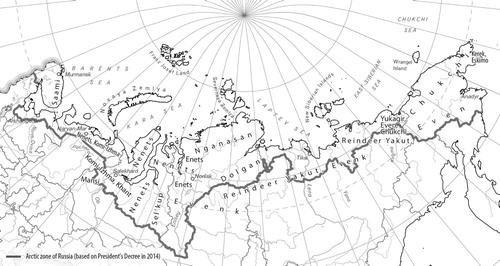
These small societies live in the Arctic coastal zone and may be affected by the plans to revitalize the Northern Sea Route. Recently, it received another name – the Ice Silk Road – after Chinese efforts to develop economic contacts via revitalization of the famous Silk Road (). This project is of great interest for Asian countries. Chinese state-owned shipping company Cosco was the first in the world to send a container ship through the Northern Sea Route in 2013. It sent already five ships in 2016 through the Northern Sea Route (25% from the total).
This project takes advantage of thawing caused by global warming to establish a northern sea route over the Russian Arctic. The Ice Silk Road is a multipurpose and multifunctional project. It consists of a number of relatively independent but closely related parts which include transportation of goods along the Northern Sea Route, coastal infrastructure development, joint development of oil and gas fields alongside with construction of transport routes, creation of large oil and gas chemical complexes for processing of raw materials close to extraction fields, etc. Chinese companies already actively participate in this Arctic projects. The Ice Silk Road project is easily adapted to the Northern Sea Route development program (till 2030), adopted recently in Russia and will promote its progress. Climatic warming, especially active in the Arctic region, Russian long-term shipping experiences in the Arctic seas, hydro-meteorological and rescue services systems supplemented by atomic icebreakers fleet attract the attention to this project.
Its implementation needs renovation and further development of coastal infrastructure at several regions including territories of traditional nature use (TTNU) and old settlers’ areas. Using TTNU term, we followed the well-established terminology adopted in English-language academic literature, though the better term is ‘nature management’ used in Russian scientific literature, scoping with material, institutional and spiritual aspects of indigenous population land use systems. New logistic, transport and storage complexes construction are planned in the coastal zone. Anthropogenic impact growth connected with the implementation of the Northern Silk Road project needs elaboration of adequate measures for mitigation of negative environmental changes.
Modern international approach to economic development in the Arctic zone declares the necessity to follow sustainable development principles. Coastal infrastructure of the Northern Silk Road must be environmentally and socially friendly to avoid disturbances in ecosystems and local communities. It is known that Arctic ecosystems are unstable to anthropogenic disturbances. Nowadays, there are already more than 20 environmental hot spots in the Russian Arctic. Each of them is surrounded by environment impact zones of various sizes. Indigenous communities face assimilation processes promoted by TTNU decline and loss in impact zones. Modern climatic changes promote different risks for reindeer breeding, hunting and fishing, and increase the rate of these processes. Thus, every new step in economic development in this region needs special measures to avoid negative consequences for man and nature (Dushkova, Krasovskaya, and Evseev Citation2017).
To meet ecological and social sustainable development tasks in the Arctic, ecological buffer territories are needed for reproduction of supporting, provisioning and regulating ecosystem services beneficial both for the ecosystem and local communities’ sustainable development (Krasovskaya and Evseev Citation2016). It is known that nature conservation territories of different ranks provide ecological buffer functions. But random distribution of such territories and their absence in some regions put forward the necessity of further development of this structure. If such territories are large enough, they may fulfill another important function – reflect climatically induced ecosystem changes producing certain risks for sustainable development. Thus, they may successfully complete monitoring functions of modern nature conservation structure whose total square and distribution are still far from the recommended by the Arctic Council (7% vs. 15%).
In this respect, a new look at TTNU of indigenous population living in the Arctic coastal zone is necessary. Maybe there is no need to regard such territories as only production units in market economy and it is time to attribute other functions to them – nature conservation, social, monitoring, ethnic-cultural, etc., in territorial planning? To prove this statement, we used an ecological-economic approach in our case study of an indigenous community living in the coastal zone of the Russian Arctic Region in Nenets Autonomous Okrug (region).
1.1. Indigenous population and TTNU in the Russian Arctic
The number of indigenous population in the Russian Arctic within the recently adopted administrative limits is 82,500 or about 3% from the total population number in this region (Tishkov Citation2014) (). Nenets population is the largest among indigenous peoples of the North living in Russia (about 45,000). Part of indigenous peoples living in the Russian Arctic are still nomadic: at the Taymyr peninsula: 14.6%, at the Chukchi peninsula: 5%, in Yamalo-Nenets Autonomous Okrug (region) up to 50–80%, etc. (Klokov and Krushev Citation2004). Most of the indigenous population live in the coastal zone: more than 21,000 Evens and Evenks, and 7000 Dolgans, Nenets, Chuckchi, etc. They may experience all advantages and disadvantages connected with plans of active transport Northern Silk Road exploitation (State Program Citation2004).
Economic development programs for the Russian Arctic zone have special chapters devoted to ecology and indigenous population. The necessity of nature conservation and ecologically safe technologies use is declared. The mainstream of the state policy concerning indigenous peoples is shown in (State Program Citation2016). According to the Russian legislation, their traditional nature management lands may be used for other purposes (oil extraction, for example) only after special agreements with indigenous communities and compensatory mechanisms should be foreseen.
Indigenous peoples TTNU include reindeer breeding, hunting, fishing and wild plants picking. In its historical variant (i.e. before market relations development), it was mostly ecologically friendly. Traditional ecological knowledge was accepted by indigenous communities during many centuries of contacts with fragile ecosystems. It supplies ecologically safe variants for modern nature management as well: low settlements size, ‘nomadic’ variant of resources exploitation, containing certain periods for ecosystem restoration, ecological ethic rules, etc. (Krasovskaya Citation2011). Nowadays, such type of nature management has been partly restored after a long period of decline after collectivization processes in the USSR. TTNU nowadays have three main functions ().
Their cultural and social functions are important for ethnic identities and cultural heritage preservation. The ecological function demonstrates support of ecosystems services reproduction in the ecologically friendly nature management. Economic function presents commercial production produced there and is of relatively minor importance compared to the previous two. The commercial value of indigenous communities production (reindeer meat, fish, skins, etc.) is incomparable with that of hydrocarbons extraction at traditional nature management lands. Different combinations of traditional and modern functions mentioned above may promote or hamper sustainable territorial development regarding ecological and social aspects. Sustainable nature management patterns developed by local ethnic-tribal communities present a valuable characteristic of their cultural landscapes – unique correlation social-natural systems preserved in the Arctic. Indigenous historical cultural landscapes nowadays exist only within family-clan communities lands, though their virtual limits may be larger and well known to indigenous population, thus helping to preserve regional identities (Krasovskaya Citation2011).
1.2. Modern threats to sustainable development of TTNU connected with the Ice Silk Road infrastructure and important control measures
Several threats exist nowadays to TTNU. Among the most important are climate change and modern practice of economic prioritization used in territorial planning. Climatic warming causes permafrost active melting, coasts abrasion in several regions and bogging. Heightened summer temperatures and increased snow thickness are unfavorable for reindeer breeding. Marine mammals hunting from ice became more difficult because of its fragility during hunting season. Traditional nature management meets a poorly controlled climatic threat for existence.
The economic prioritization threat is explained by the fact that in modern practice of territorial planning, it is quite common that land use patterns bringing lower income are undervalued and thus are less competitive. According to the Russian legislation, green infrastructure (ecological buffer territories) development is obligatory for territorial planning, but its size may differ considerably. Traditional elements of green infrastructure include nature conservation lands at river banks, climate regulating forests, nature reserves, etc. Their total square is not assessed regarding ecosystem services regulation functions (Krasovskaya Citation2013; Krasovskaya and Evseev Citation2016). Green infrastructure development demands money investments and certain territories loss for production. Federal and regional administrations financing is mainly used for this purpose and as a rule is not enough.
Climate change-induced situation is difficult to control, but economic prioritization practice may be improved. The Ice Silk Road costal infrastructure may interfere indigenous peoples TTNU in several regions of the coastal zone: the Indiga river mouth (Russian old settlers and Nenets) capes Varandey and Kharasavey (Nenets), the Yana downstream region (Evens and Evenks), the Kolyma river mouth (Russian old settlers, Yukaghirs, etc.), Western Chukchi region (Chukchi), etc. (State Program Citation2014). Nowadays compensatory mechanisms for replacement/disruption of traditional nature management territories are based on ‘lost profits’ theory. But profits are regarded as mainly biological resources providing traditional economy of indigenous population: reindeer pastures, reindeer herds, some hunting and fishing resources, i.e. provisioning ecosystem services. Regulating and supporting ecosystem services are not considered though they support the process of ecological stability making social-economic development possible.
We tried to assess several regulating ecosystem services for a traditional nature management land in the European coastal Arctic zone of Russia and elaborate the methodology for social (ethnic-cultural) ecosystem provisioning ecosystem services assessment. This investigation follows the mainstream of the ongoing TEEB joint project of CAFF (Arctic Council) (Progress Report on the Economics and Biodiversity (TEEB) Citation2015, Mapping and Assessment of Ecosystems and their Services (MAES) Citation2016, UNEPGEO projects and WWF projects), UNEPGEO projects and WWF projects. The true value of TTNU will give them a chance to provide ecological buffer zones for the Ice Sea Road coastal infrastructure thus preserving Arctic ecosystems and indigenous peoples identities.
2. Study area
2.1. General description
We have chosen traditional nature management lands for our study in Nenets Autonomous Okrug (region) (). Its administration tries to preserve ethnic-cultural nature management traditions of indigenous population mainly Nenets (about 7500 living there). Nomadic population total number exceeds 1500 people (Hantazeisky Citation2013). Nenets reindeer breeders are united in family-clan communities, aborigine agricultural cooperatives, and are presented as private owners and by state enterprises. Lands belonging to the Union of family-clan community ‘Ya’Erv’ are situated in Zapolyarny region in the coastal zone of the Nenets Autonomous Okrug present our study area. This community was formed in 1998 and united several former agricultural collective farms which existed in the Soviet Union. Its total area exceeds 600,000 ha (). Our choice was explained by the fact that this territory possessed ecological-geographical data necessary for our assessments due to recent studies conducted at this territory within GEF and UNEP projects (Mihalev et al. Citation2008) as well as personal field research experiences. Another reason is that its anthropogenic changes nowadays are not large, compared to other neighboring territories. This enables to regard this territory as an ecological buffer zone for the Northern Silk Road with all functions mentioned above.
2.2. Natural ecosystems and anthropogenic impact
The study area occupies the Pechora lowland with absolute heights about 200 m and is characterized by severe climatic conditions. The major part of the land cover is presented by tundras (45%) and peat bogs (20%). Twelve percent are occupied by forest-tundra vegetation, 5% by meadows and 11% by water bodies (Mihalev et al. Citation2008). The rest 7% is occupied by northern taiga. The following local landscape types are presented at this territory: (1) Bogged marine coast; (2) Heightened plains, Hylchuu-Neebteyaha region; (3) Flat plains, the Chernaya river region; (4) Heightened plains, the Shapkina river region; (5) Forest-tundra, the Kuya river region; (6) Northern taiga, the Brevenniza river region (Mihalev et al. Citation2008). More than 12 hydrocarbon deposits with extraction sites are situated at the territory. The most typical are damage and loss of reindeer pastures and fishing sites because of pollution and mechanical disruptions. Development of coastal Ice Silk road infrastructure may increase anthropogenic impact. This fact draws attention to ecosystem-preserving role of TTNU – an important component of regional ‘green infrastructure’ (Krasovskaya and Evseev Citation2016).
3. Materials and methods
We regarded ‘Ya’Erv’ family-tribal community TTNU as a social system linked to its ecosystem through the interchange of energy, materials and information (Rambo Citation1983). This ethnic-cultural community living on its tribal lands presents a social-natural correlation system. Different from European indigenous world outlook often makes such systems ‘invisible’ for newcomers, thus producing ethnic-cultural nature management conflicts (Krasovskaya Citation2011).
Traditional ecological knowledge provided sustainable nature management pattern development for many years. It was adapted to ecosystems carrying capacity, thus preserving natural capital. Nevertheless, many ecosystem services (mainly regulating, important for regional sustainable development) which form this capital are ignored nowadays presenting ‘The tragedy of the commons’ (Hardin Citation1968). Taxes paid for environmental disruptions are far from the real value of lost ecosystem services.
Ecological-economic assessments of natural capital here include studies of provisioning and regulating ecosystem services. In our studies, we used assessments of biological ecosystem services (reindeer pastures, wild berries, etc.) presented in the GEF/UNEP project mentioned above to compare inputs to natural capital. They included: reindeer pastures production, hunting resources, berries and medical plants resources in accordance with spatial distribution of providing ecosystems patterns. Market price assessment was the main tool for that work (Mihalev et al. Citation2008).
Ecosystem services assessed in this project were carbon deposition by different ecosystems (climate regulation function due to CO2 consumption), water purification and ‘warming’ effect of bogs, ethnic-cultural provisioning environmental service and non-use value. This list was limited by available data and assessment methods.
We used traditional methods for ecological services assessment based on their existing and possible market prices (Dixon et al. Citation1994). We suggested an original method of ethnic-cultural service assessment. It was based on a concept that local ecosystems provided foodstuffs, clothes, building materials, etc., for Nenets ethnic groups existence, thus presenting an ethnic-cultural provisioning function of nature. Its assessment was based on market prices of local foodstuffs and materials produced in Nenets communities. Local statistics were used for these purposes (market prices for reindeer products, berries, etc., municipal prices for heating and water purification, etc.). Published data concerning regulating ecosystem services for carbon deposition was used (Costanza et al. Citation2014; Elsakov and Haikennen Citation2003; Liss et al. Citation2001; Voronov, Usol’zev, and Chasovskyh Citation2012; Zavarzin Citation2007; Zamolodchikov Citation2003, etc.). Experimental results applicable to the studied region were borrowed from these publications. The absence of experimental data on carbon deposition related to the study area was completed by adequate data referred to similar ecosystems at adjacent territories of the Arctic zone. CH4 emission rate was negligible for this territory compared to deposition due to location in a relatively stable permafrost zone.
Water purification service assessment was based on analogies method. Total virtual bogs water purification capacity was assessed. Water purification ecosystem service existed due to water filtration capacity. Using H. Darcy law, Ivanov (Citation1957) calculated an average filtration capacity in bogs: 0.015 cm/day for peat bogs and 0.005 cm/day for grass bogs. Filtration process was limited by warm period, i.e. up to 3 months. Water purification service was assessed as an analogy of local water purification service (price for municipal sewage treatment – 20 r/m3) (Prices for municipal sewage Citation2016).
Bogs ‘warming’ service is explained by increase up to 10% of radiation balance at bogged territories compared to drylands. This phenomenon is typical for northern regions (Romanov Citation1961). For example, field data demonstrated that air temperature increase in Western Siberia during cold period was 2°C due to warming effect of bogs (IMCES Citation2002). Radiation balance in our case was 10–12 kkal/cm2/year. Warming effect was assessed in local price units for heating – 1166 r/1 Gkal in 2016 (Prices for municipal sewage Citation2016). ‘External warmth’ produced by local bogs thus received social price.
Non-use value assessment was based on the average lands reclamation price for the region – up to 1.8 million r/ha (State Program Citation2014). This price may be regarded as non-use value of restored lands.
4. Results and discussion
4.1. Results
Regulating and provisioning ecosystems services value, i.e. ecosystems input to ecological and social stability of the discussed area, appeared to be comparable with its commercial value.
4.1.1. Carbon deposition service
Using data on carbon deposition by different ecosystems, we calculated total and proportional value of this ecosystem service responsible for climate control. Market economy price of a carbon dioxide according to Kyoto Protocol is 10 USD per 1 t CO2 exhaust. Correlation coefficient C-CO2 is 3.66. Proportional value is shown in .
Table 1. Proportional value of terrestrial ecosystem services for ‘Ya’Erv’.
4.1.2. Bogs ‘warming’ service
Increase in radiation balance due to bogs warming effect was about 1.1 kkal/cm2. Warming effect from the bogged territories appeared to be 18174.8 Gkal. Proportional value is shown in .
4.1.3. Bogs water purification (filtration) service
Filtration capacity of peat bogs is 20,312,235 m3. Filtration capacity of grass bogs is 664,380 m3. Proportional value is shown in .
4.1.4. Ethnic-cultural service
The main domestic product in Nenets communities was reindeer that supply foodstuffs (meat and blood) and skin for traditional clothes and wigwams. Low salaries of nomadic population compared to regional make reindeer products an important item for indigenous communities’ existence. Reindeer herd number in the family-clan community ‘Ya’Erv’ in 2014 was 11,530. Part of it was sold. The price of the remaining herd – 27 million rubles – was calculated using local prices (90 r/kg including skins, horns, etc.) and average reindeer weight. Proportional value is shown in .
Only 17.5% of wild berries were picked. Their price for the community was based on local market prices – 7142 rubles (Mihalev et al. Citation2008). Thus, the value of ethnic-cultural services of terrestrial ecosystems was 0.9 million USD, proportion value – 1.5 USD/ha. This value may be higher if hunting resources value (within amounts providing reproduction capacity) were considered +0.9 USD/ha. We failed to receive data about the amount of these resources consumption by local community. Virtual proportional value of ethnic-cultural service with included average hunting resources value available at the territory was 2.4 USD/ha.
4.1.5. Non-use value
The area of abandoned lands after hydrocarbons extraction was 2175 ha (Mihalev et al. Citation2008). Non-use value is 130.5 million USD, proportion value – 0.06 million USD/ha.
Assessment results presented as proportional value of ecosystem services supply are shown in . Proportional value may be easily compared with cadaster value used for compensatory measures to family-clan communities in case their lands are planned to turn to another land use category. Assessment data were used for thematic map compilation ().
4.1.6. Mapping
Approaches and workflow for mapping were developed within the frames of Target 2 Action 5 Mapping and Assessment of Ecosystems and their Services (MAES) of the EU Biodiversity Strategy. They present technologies for various ecological data arrangement for mapping. These efforts may be regarded as the first step for ecosystem services economic assessment and deal mainly with individual ecosystem elements and their anthropogenic transformation. Recently, a similar mapping program was launched in Nenets AO sponsored by GEF and Ministry of Natural Resources of Russia. GIS technologies were used for compiling a geoecological regionalization map (Konovalova and Shumilova Citation2008).
An economic assessment map of resource ecosystem services for the studied area was compiled earlier (Mihalev et al. Citation2008). Our studies enabled to compile an ecological-economic map (), demonstrating a larger spectrum of ecosystem services than shown at the above-mentioned map. Such maps compilation may be regarded as movement towards development of an ecological-economic Atlas information system which presents the top level of electronic atlases supporting scenario approach to territorial planning procedure and decision-making (Ormeling Citation1995; Tikunov Citation2004; Yablokov and Tikunov Citation2016). They comprise advances modeling functions, may integrate expert systems and be presented as multimedia constructions. Spatial data visualization is their valuable service.
4.2. Discussion
The received results may be regarded as an attempt to assess regulating and provisioning ecosystem services for the study area and may be regarded as primary assessments which may be completed by new data both on methods and information base. This was never done before. The future assessment may increase the received value due to larger ecosystem services spectrum (refugium, water regulating, etc.). Permanent growth of tariffs and prices used in this work will only increase the received values. The received values of ecosystem services per 1 ha demonstrate fair correspondence to similar assessments (Costanza et al. Citation2014; De Groot et al. Citation2006). Variations may be explained by different scales of assessments.
We compared the proportional value of some ecosystem services with the existing lands value – maximal 132 USD/ha (Mihalev et al. Citation2008). Proportional value for regulating services of peat bogs, for example, appeared to be nearly the same (). If we add the average proportional value for wild berries and plants (45.8 USD/ha), i.e. provisioning ecosystem service, the value for bogs ecosystem services will be 1.2 times higher. Mean proportion value of carbon deposition ecosystem service appeared to be practically the same as that of bio-production service (i.e. berries, pasture resources, etc.), but it is ignored in TTNU official prices, thus reflecting ‘the tragedy of the commons’.
Our results present a quantitative economic argument to preserve traditional TTNU as ecological buffer territories useful for monitoring, nature conservation, etc., but not mainly for economic production. Even limited assessment of ecosystem services value demonstrates their input to ecological and social (for this local indigenous community) stability. Monetary assessment may to a certain extent reveal possible future expenditures for environment restoration caused by anthropogenic impact. Such expenditures should be kept in mind though they may increase the price of investment projects considerably in the Ice Silk Road coastal zone. This is of vital importance to meet sustainable development demands for territories of future economic development, the North Silk Road being one of them. Alternative variants of land use including TTNU may sometimes appear to be more meaningful for regional sustainability than industrial.
5. Conclusion
The assessment presented in this study fully corresponds the AkwéKon guidelines adopted within the International Convention on Biodiversity. This document includes voluntary guidelines for cultural, environmental and social impact assessments regarding developments proposed to take place on/or which are likely to impact on sacred sites and on lands and waters traditionally occupied or used by indigenous and local communities (AkwéKon Citation2004). We used these Guidelines in our previous ecological-economic assessments (Krasovskaya Citation2013) of indigenous minorities’ lands to prove the fact that their cost is much higher than used in modern economic assessments. This fact promotes the replacement of TTNU by more ‘economically valuable’ industrial land use (extraction of mineral resources and transport infrastructure development) especially in connection with the expected relatively quick future incomes. Still large areas of reserved lands (for future exploitation) with planned enlargement of nature reserve territories produce an illusion of an adequate territorial land management meeting sustainable development targets. The same is true for the Arctic coastal zone and plans for the Northern Silk Road. Negative ecological effects of its development are discussed mainly for the marine environment. Acknowledging a great socioeconomic significance of the Northern Silk Road development, territorial planners have no reasonable arguments for preservation of TTNU.
Our assessment enabled to demonstrate in terms clear for territorial economic planning a new look on TTNU in the Arctic coastal zone. This fact gives a chance to prove the necessity to attribute TTNU new functions important for nature conservation, environment monitoring, providing ecosystem services at a regional scale, etc. The ongoing process of markets development for regulating ecosystem services promotes ‘greening’ of territorial planning practice in many regions, including Nenets Autonomous Okrug. The Ice Silk Road coastal infrastructure planning may integrate TTNU as ecological buffers capable to restore anthropogenically disturbed ecosystem services and monitor their changes in time. This measure may reduce future environment restoration expenditures connected with coastal infrastructure development. Thus, the Northern Silk Road principle economic role may be completed by social and ecosystems preserving and monitoring as well (Dushkova, Krasovskaya, and Evseev Citation2017). The Northern Silk Road coastal infrastructure planning with integrated ecological-economic assessment may demonstrate a new approach for the Arctic zone economic development meeting requirements of sustainable development.
Disclosure statement
No potential conflict of interest was reported by the authors.
Additional information
Funding
References
- AkwéKon. 2004. Guidelines. Montreal: CBD.
- Costanza, R., R. de Groot, P. Sutton, S. van der Ploeg, S. Anderson, I. Kubiszewski, S. Farber, and R. Turner. 2014. “Changes in the Global Value of Ecosystem Services.” Global Environmental Change 26: 152–158. doi: 10.1016/j.gloenvcha.2014.04.002
- De Groot, R., M. A. M. Stuip, C. M. Finlayson, and N. Davidson. 2006. Valuing Wetlands. Gland, Ramsar Technical Report 3.
- Dixon, J. A., L. F. Scura, R. A. Carpenter, and P. B. Sherman. 1994. Economic Analysis of Environmental Impacts. 2nd. ed. London: Earthscan.
- Dushkova, D., T. Krasovskaya, and A. Evseev. 2017. “Environmental & Human Impact of the Northern Sea Route and Industrial Development in Russia’s Arctic Zone.” In Arctic Yearbook 2017: Change & Innovation in the Arctic: Policy, Society & Environment, Arctic Resources & Development. Arctic Resources & Development, edited by L. Heininen, H. Exner-Pirot, and J. Plouffe, Vol. V., 275–289. Akureyri, Iceland: Northern Research Forum .
- Elsakov, V. V., and Yu Haikennen. 2003. “Seasonal Greenhouse Gases Balance in Natural Ecosystems of Vorkuta Tundra.” [in Russian]Proceedings of the III International Conference “Cities of the Arctic Zone and Environment”, Vorkuta, 127–130.
- Hantazeisky, Yu. 2013. Nenets AO and the Russian Arctic [in Russian]. http://www.iarex.ru/articles/38049.html.
- Hardin, G. 1968. “The Tragedy of the Commons.” Science 162 (3859): 1243–1248. doi: 10.1126/science.162.3859.1243
- IMCES Tomsk Scientific Center. 2002. RAS: The Most Important Achievements Tomsk [in Russian]. https://news.yandex.ru/yandsearch?text=6.IMCES Tomsk Scientific Center, RAS.
- Ivanov, K. E. 1957. Fundamentals of Bogs Hydrobiology in a Forest Zone [in Russian]. Leningrad: Hydro-Meteorological Publ. House.
- Klokov, K., and S. Krushev. 2004. Reindeer Breeding of Indigenous Peoples in Russia [in Russian]. Information-Analytical review. Sankt-Peterburg.
- Konovalova, N. V., and Yu N. Shumilova. 2008. “Metodology of Geoecological Regions Mapping in GIS Media Exemplified by NAO.” [in Russian]Vestnik Pomorskogo universiteta 2: 70–75.
- Krasovskaya, T. 2011. “Aborigine Cultural Landscapes of the Russian North as Heritage Objects.” Geography, Environment, Sustainability 4: 129–138. doi: 10.24057/2071-9388-2011-4-3-129-138
- Krasovskaya, T. 2013. “Ecological-Economic Assessment of TTNU as a Part of Ecological Framework at the Russian North.” [in Russian]Proceedings of the International Conference of the Russian Ecological-Economic Society, Irkutsk, 51–54.
- Krasovskaya, T., and A. Evseev. 2016. “Methodology of Ecological Buffer Territories Development in Impact Zones of the Russian Arctic.” Proceedings of the 1st steps Collaboration Seminar for Sustainable Development. Tokyo, 104–110.
- Kulintsev, Yu. V. 2015. “‘One belt- one way’ – An Initiative with Chinese Specific Feature//Russian International Affairs Council 22/05/2015. Accesseded 26 September 2016. http://russiancouncil.ru/blogs/riacexperts/?id_4=1868. [in Russian].
- Liss, O. L., L. I. Abramova, N. A. Aletov, N. A. Berezina, L. I. Inisheva, T. V. Kurnishenkova, Z. A. Sluka, T. Yu Tolpysheva, and N. K. Shvedchikova. 2001. Western Siberia Bogs System and Their Nature Conservation Status [in Russian]. Moscow: Moscow University Press.
- Mapping and Assessment of Ecosystems and their Services. 2016, Final March. Mapping and Assessing the Condition of Europe’s Ecosystems: Progress and Challenges. 3rd Report. European Environment Agency. Accessed 20 January 2017. http://ec.europa.eu/environment/nature/knowledge/ecosystem_assessment/pdf/3rdMAESReport_Condition.pdf.
- Mihalev, G. A., O. A. Murashko, V. I. Kurakin, V. V. Yanina, and L. V. Mihaleva. 2008. “Assessment of Indigenous Population of the North, Siberia and the Far East of Russia Traditional Nature Management Lands Quality.” [in Russian] Batany, Moscow.
- Ormeling, F. 1995. “Atlas Information Systems.” 17th international Cartography Conference and 10th General Assembly ICA. Barcelona, Sept. 3rd–9th. Proceedings, 2: 2127–2133.
- Prices for municipal sewage treatment and heating. 2016. http://www.adm-nao.ru [in Russian].
- Programme 2012–2014. 2012. Nordic Council of Ministers. Kopenhagen. 2012. http://www.norden.jrg.
- Progress Report on the Economics and Biodiversity (TEEB). 2015, April. Scoping Study for the Arctic. CAFF.
- Rambo, T. 1983. “Conceptual Approaches to Human Ecology.” East-West Environment and Policy Institute Research Report East-West Center, Honolulu, Hawaii 14.
- Romanov, V. V. 1961. Hydrophysics of Bogs [in Russian]. Leningrad: Hydro-Meteorological Publ. House.
- State Program. 2004. “Social-Economic Development of the Arctic Zone of the Russian Federation up to 2020.” [in Russian] Accessed April 24, 2004. http://www.pravo.gov.ru
- State Program. 2014. “Environment Conservation, Reproduction and Exploitation of Natural Resources.” [in Russian] http://www.nao-adm.
- State Program of the Russian Federation on National policy. 2016. Moscow (2016) [in Russian].
- Tikunov, V. S. 2004. “Atlas Information Systems for Decision Making.” In Fundamentals of Geoinformatics [in Russian], 285–304. Moscow: Academia Press.
- Tishkov, V. A. Indigenous Peoples of the Russian Arctic: Modern Status and Future [in Russian]. Report at the General Assembly of RAS (December 16, 2014) http://iea-ras.ru/index.php?go=News&in=view&id=528.
- Voronov, M. P., V. A. Usol’zev, and V. P. Chasovskyh. 2012. Studying Methods and Designing Information System for Calculating and Mapping of Forest Deposed Carbon in Natural Software [in Russian]. Yekaterinburg: Ural State Forest Engineering University.
- Yablokov, V. M., and V. S. Tikunov. 2016. “Atlas Information Systems for Sustainable Development of Territories.” [in Russian] Intercarto/InterGIS 22: Proceedings of the International Conference, Protvino: Nauchnaya Biblioteka Publishing House, 1, 13–33.
- Zamolodchikov, D. 2003. “Carbon Balance in Tundra and Forest Ecosystems in Russia.” [in Russian] Doctor of Science Degree thesis, Moscow.
- Zavarzin, G. A., ed. 2007. Terrestrial Ecosystems Pulls and Fluxes in Russian Ecosystems [in Russian]. Moscow: Nauka.

